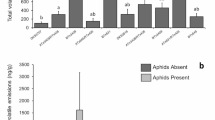Abstract
The feeding deterrency of a series of pyrrolizidine, indolizidine, and quinolizidine alkaloids and selected derivatives was measured against the pea aphid (Acyrthosiphon pisum Harris). The indolizidine alkaloid, castanospermine, was intensely active (ED50, 20 ppm) as were the quinolizidine alkaloids, but only modest feeding deterrency was observed with most of the pyrrolizidine alkaloids tested. The insect survival rate of aphids on a castanospermine-supplemented diet over 24 hr was also very low relative to the controls. Castanospermine does not inhibit aphid trehalase. The indolizidine alkaloid swainsonine occurred in the honeydew of pea aphid feeding on the locoweed,Astragalus lentiginosus. Since the pea aphid is a phloem feeder, swainsonine must be transported in the phloem.
Similar content being viewed by others
References
Akey, D.H., andBeck, S.D. 1971. Continuous rearing of the pea aphidAcrythosiphon pisum, on a holidic diet.Ann. Entomol. Soc. Am. 64:353–356.
Bull, L.B., Culvenor, C.C.J., andDick, A.T. 1968. The Pyrrolizidine Alkaloids. North-Holland, Amsterdam.
Candy, D.J., andKilby, B.A. 1975. Insect Biochemistry and Function. Chapman and Hall, London.
Campbell, B.C., andDreyer, D.L. 1985. Host-plant resistance of sorghum: Differential hydrolysis of sorghum pectic substances by polysaccharases of greenbug biotypes (Schizaphis graminum, Homoptera: Aphididae).Arch. Insect Biochem. Physiol. 2:203–215.
Culvenor, C.C.J., andSmith, L.W. 1955. The alkaloids ofErectites quadridentata D.C.Aust. J. Chem. 8:556–561.
Culvenor, C.C.J., Edgar, J.A., Smith, L.W., andTweeddale, H.J. 1970. Dihydropyrrolizines III. Preparation and reactions of derivatives related to pyrrolizidine alkaloids.Aust. J. Chem. 23:1853–1867.
Dorling, P.R., Chambers, J.P., andColegate, S.M. 1980. Inhibition of lysosomal α-mannosidase by swainsonine, an indolizidine alkaloid isolated fromSwainsona canescens.Biochem. J. 191:649–651.
Dreyer, D.L., andCampbell, B.C. 1983. Association of the degree of methylation of intercellular pectin with plant resistance to aphids and with induction of aphid biotypes.Experientia 40:224–226.
Dreyer, D.L., Reese, J.C., andJones, K.C. 1981. Aphid feeding deterrents in sorghum. Bioassay, isolation, and characterization.J. Chem. Ecol. 7:273–284.
Johnson, A.E., Molyneux, R.J., andMerrill, G.B. 1985. Chemistry of toxic range plants. Variation in pyrrolizidine alkaloid content ofSenecio, Amsinckia, andCrotalaria species.J. Agric. Food Chem. 33:50–55.
Jones, T.H., andBlum, M.S. 1983. Arthropod alkaloids: Distribution, functions and chemistry.In S.W. Pelletier (ed.). Alkaloids: Chemical and Biological Perspectives. Wiley, New York, vol. 1., pp. 34–84.
Matile, P. 1984. Das toxische Kompartiment der Pflanzenzelle.Naturwissenschaften 71:18–24.
McLean, D.L., andKinsey, M.G. 1967. Probing behavior of the pea aphid,Acyrthosiphon pisum I. Definitive correlation of electronic recorded waveforms with aphid probing activities.Ann. Entomol. Soc. Am. 60:400–405.
Molyneux, R.J., andJames, L.F. 1982. Loco intoxication: Indolizidine alkaloids of spotted locoweed (Astragalus lentiginosus).Science 216:190–191.
Molyneux, R.J., andJohnson, A.E. 1984. Extraordinary levels of production of pyrrolizidine alkaloids inSenecio riddellii.J. Nat. Prod. 47:1030–1032.
Molyneux, R.J., Johnson, A.E., Roitman, J.N., andBenson, M.E. 1979. Chemistry of toxic range plants. Determination of pyrrolizidine alkaloid content and composition inSenecio species by NMR Spectroscopy.J. Agric. Food Chem. 27:494–499.
Molyneux, R.J., Roitman, J.N., Benson, M., andLundin, R.E. 1981. [13C]NMR spectroscopy of pyrrolizidine alkaloids.Phytochemistry 21:439–443.
Murao, S., andMiyata, S. 1980. Isolation and characterization of a new trehalase inhibitor, S-GI.Agric. Biol. Chem. 44:219–221.
Niwa, T., Inouye, S., Tsuruoka, T., Koaze, Y., andNiida, T. 1970. Nojirimycin as a potent inhibitor of glucosidase.Agric. Biol. Chem. 34:966–968.
Pollard, D.G. 1973. Plant penetration by feeding aphids (Hemiptera, Aphidoidea): A review.Bull. Entomol. Res. 62:631–714.
Reese, E.T., Parrish, F.W., andEttlinger, M. 1971. Nojirimycin and D-glucono-1,5-lactone as inhibitors of carbohydrases.Carbohydr. Res. 18:381–388.
Rose, A.F., Jones, K.C., Haddon, W.F., andDreyer, D.L. 1981. Grindelane diterpenoid acids fromGrindelia humilis: Feeding deterrency of diterpene acids towards aphids.Phytochemistry 20:2249–2253.
Saul, R., Chambers, J.P., Molyneux, R.J., andElbein, A.D. 1983. Castanospermine, a tetrahydroxylated alkaloid that inhibits β-glucocerebrosidase.Arch. Biochem. Biophys. 221:593–597.
Smith, B.D. 1966. Effect of the plant alkaloid sparteine on the distribution of the aphidAcrythosiphon spartii (Koch.).Nature 212:213–214.
Tulsiani, D.R.P., Harris, T.M., Touster, D. 1982. Swainsonine inhibits the biosynthesis of complex glycoproteins by inhibition of Golgi mannosidase II.J. Biol. Chem. 257:7936–7939.
Wegorek, W., andKrzymanska, J. 1970. Investigation on the biochemical causes of some lupine varieties resistant to pea aphid (Acynhosiphon pisum Harris).Biol. Abstr. 51:63590.
Wink, M., andWitte, L. 1984. Turnover and transport of quinolizidine alkaloids. Diurnal fluctuations of lupanine in the phloem sap, leaves, and fruits ofLupinus albus L.Planta 161:519–524.
Wink, M., Hartman, T., Witte, L., andRheinheimer, J. 1982. Interrelationship between quinolizidine alkaloid-producing legumes and infesting insects: Exploitation of the alkaloid containing phloem sap ofCytisus scoparius by the broom aphidAphis cytisorum.Z. Naturforsch. 37c:1081–1086.
Author information
Authors and Affiliations
Rights and permissions
About this article
Cite this article
Dreyer, D.L., Jones, K.C. & Molyneux, R.J. Feeding deterrency of some pyrrolizidine, indolizidine, and quinolizidine alkaloids towards pea aphid (Acyrthosiphon pisum) and evidence for phloem transport of indolizidine alkaloid swainsonine. J Chem Ecol 11, 1045–1051 (1985). https://doi.org/10.1007/BF01020674
Received:
Accepted:
Issue Date:
DOI: https://doi.org/10.1007/BF01020674




